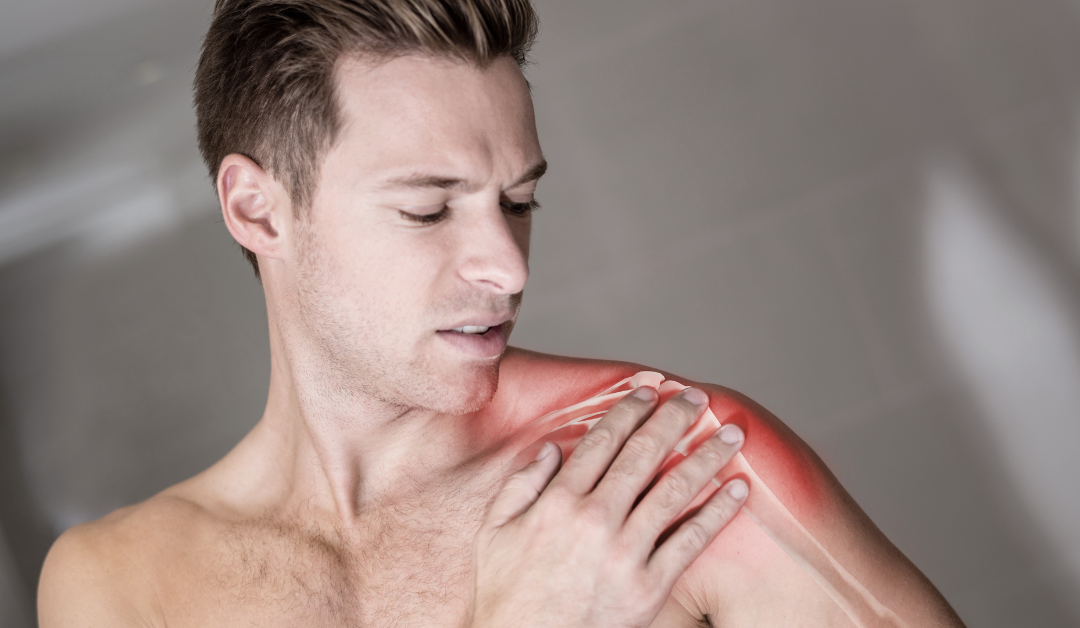Whilst most AC joint injuries are caused directly by a fall or direct impact to the shoulder, they can also occur over time, by degenerative conditions like osteoarthritis.
In this article we look at causes of this form of joint sprain, how to prevent it from occurring, and the different physical therapy options you have to treat it.
Where is the Acromioclavicular (AC) Joint?
The AC joint is where your clavicle, or collar bone, meets the shoulder bone, or scapula. It is the pointy protrusion at the top, outer edge of the shoulder, that allows you to lift your arm above your head.
This joint helps maintain the position of the shoulder to allow shoulder control, motion and strength and is stabilised by a capsule and ligaments.
What is an AC Joint Injury?
An AC joint injury refers to pain and damage to the acromioclavicular joint and/or surrounding tissues around the AC ligament. AC Joint injuries can range from a ligament tear or sprain at the AC and CC (Coracoclavicular) ligaments, to a full joint dislocation, or a break of the AC joint capsule.
When ligaments are stretched or torn, it can be very painful and the level of separation can be mild to severe. Injuries are graded depending on which ligaments are torn and how badly. The following 3 grades are the most common, however higher grades are also possible.
Grade 1 – Minor damage, possibly slight tear to the AC joint only.
Grade 2 – Torn ligaments of AC joint and also damage to the coracoclavicular ligaments, however they would be only stretched and not entirely torn.
Grade 3 – The coracoclavicular ligaments will be completely torn also and the collar bone separates from the end of the shoulder blade.

What Causes an AC Joint Injury?
Injuries can occur because of a direct impact like a collision or fall onto the shoulder, or indirectly by falling onto an outstretched arm. Indirect injuries often affect the AC ligament and not the CC ligaments. More serious Grade 3 injuries are usually from contact sports, car accidents or a fall/collision on a bicycle.
However in some cases, it can be general wear and tear on the AC joint caused by repetitive motions of the Shoulder blade and AC joint, like tradies doing heavy lifting every day.
AC Injuries can also be caused by degenerative conditions like osteoarthritis or arthritis in the shoulder joint.
What are the symptoms to look out for?
Generally symptoms will include –
- Shoulder pain or tenderness at the top of the shoulder
- Swelling or bruising at shoulder joint
- Shoulder pain when lifting heavy objects or moving arm
- Reduced range of motion of the shoulder
- Large bump at the top of shoulder
Often grade 1 injuries are more painful initially than a grade 3, as the partially torn ligaments are stressed by any movement of shoulder or arm. With grade 3, there is a complete tear so that removes all loading.
Diagnosing your AC Joint Injury
A physical examination will need to be completed along with taking your medical history into account. A range of tests will be done to assess the mobility and level of joint pain, and you may be sent for an x-ray to see how severe the injury is.
How do you treat AC Joint Injuries?
Generally an AC injury will be treated with physical therapy from an accredited physiotherapist.
Initially the inflammation should be controlled with ice and medications for the first couple of days.
Lower grade AC injuries, where the ligament tear is incomplete and the joint is still intact, are usually treated conservatively. This may start with some form of immobilisation like a brace or sling to allow the injury to heal and reduce the pain. Once healing is underway, physiotherapy can be performed to build back shoulder strength, improve range of motion and mobility, and prevent excessive scarring.
Further progressive resistive exercises will then be prescribed to further build strength in ligaments and reduce pain. These will also help prevent re-injury in the future.
With higher grade AC joint injuries, there is some debate about how to treat them most effectively. The damage to the AC joint may injure the cartilage within the joint and can later cause arthritis of the joint. Whilst some believe surgery is the only option to reduce the deformity of a full dislocation, there are also more complications and risks to consider. Please consult your health professional/s to consider all options.
The length of time required to regain a full recovery depends on the grade of injury. Generally a grade 1 will take 10-14 days, whereas a grade 3 will be 6 – 8 weeks.
The Team at SPHC can help with your AC Injury!
At SPHC, we have highly qualified Physiotherapists that can assess and diagnose your AC injury, and develop a treatment plan for your rehabilitation to get you back on track as soon as possible.
Contact us for further information on 07 3869 1099 or you can BOOK ONLINE.





